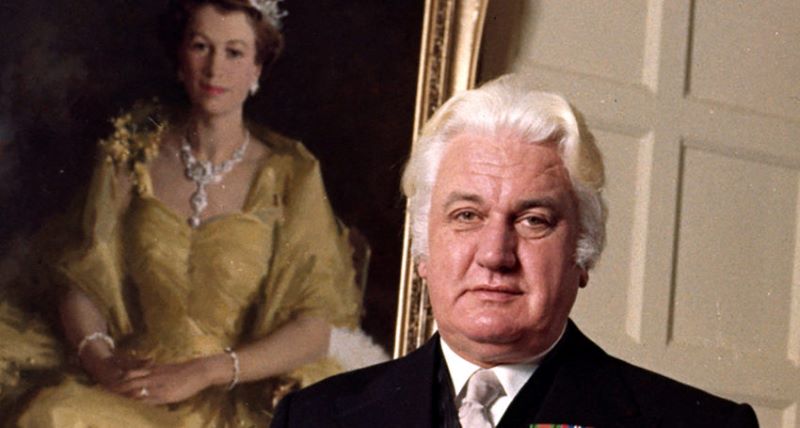
Sir John Kerr with a portrait of the Queen
You may have heard about the kerfuffle over recently published letters between Australia’s Governor-General Sir John Kerr and Buckingham Palace back in 1975.
In one sense they reveal nothing new – confirming that Sir John dismissed then Prime Minister Gough Whitlam on 11 November before he informed the Queen.
The events leading up to that dismissal have been described many times. They include the books “Matters for Judgment” by Sir John Kerr and “Head of State” by his private secretary Sir David Smith.
In October 1975, the Whitlam Government was in trouble. The Senate was refusing to pass the supply bills needed to authorise payment for Whitlam’s controversial spending program.
The Australian Constitution (s 57) wisely provides a way to resolve stalemates of this kind between the two houses of federal parliament. Prime Minister Whitlam could have asked the Governor-General to dissolve the entire parliament and hold elections for both the House of Representatives and the full Senate – a “double dissolution”.
If Whitlam had won such an election, he could have convened a joint sitting of both houses to pass the supply bills. But he refused to follow the constitutional process, possibly fearing an election loss.
What started as a political problem for Whitlam then became a constitutional problem for Kerr. Whitlam was seeking to govern without supply, in breach of the Constitution. Kerr’s duty as Governor-General was to ensure that parliament operated in accordance with the Constitution. A clash was inevitable.
The events that followed throw considerable light on the “reserve powers” of the Governor-General.
The Governor-General’s “ordinary powers” include assenting to laws passed by both houses of parliament and acting in accordance with the advice of Commonwealth ministers. In a small number of matters, the Governor-General exercises “reserve powers”, acting without ministerial advice.
The two most important reserve powers are to appoint or dismiss the Prime Minister (s 64). Ordinarily, by convention, the Governor-General will appoint the leader of the party or coalition with a majority in the House of Representatives. In unusual circumstances, the Governor-General may dismiss or appoint a Prime Minister on his own initiative.
On 11 November 1975, John Kerr was faced with a situation that needed to be resolved by the Australian people in a general election. Since calling an election is an “ordinary power”, Kerr could only do this on the advice of the Prime Minister, which Whitlam refused to give. The only way an election could be called was for Kerr to dismiss Whitlam and appoint Malcolm Fraser as caretaker prime minister, on condition that Fraser would advise him to call an election.
Fraser agreed. The election a few weeks later gave him a landslide win, endorsing the Governor-General’s action.
The correspondence with the Palace confirms that the Queen could not tell Kerr what to do, since the reserve powers of the Crown under the Australian Constitution can only be exercised by the Governor-General.
These events, and the Palace letters, confirm that the Constitution makes the Governor-General the effective Australian Head of State.
Those who are campaigning for “an Australian Head of State” ignore the fact that the past eleven Governors-General have all been Australians – from Sir Paul Hasluck in 1969 to David Hurley today.
Australia has one of the oldest constitutions in the world. Drafted by leading Australian statesmen, many of whom professed a Christian faith, it has given us stable government for nearly 120 years.
FamilyVoice has defended the Australian Constitution for nearly 50 years, and will continue to do so with your help and support.
Peter Downie - National Director

